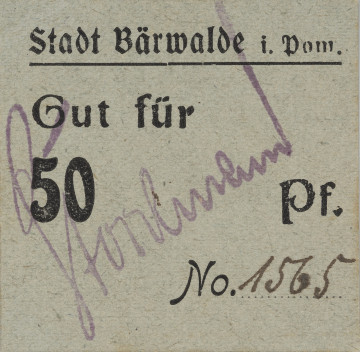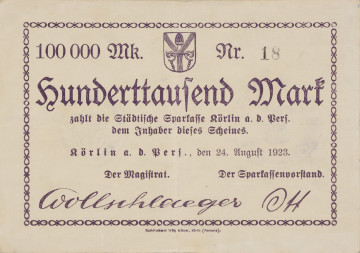
50 pfennigs
1921
National Museum in Szczecin
Part of the collection: Paper money
At the end of the summer of 1923, the German currency entered a phase of galloping inflation, to which the issuers of substitute money also reacted. In the last days of August, the issuance of bills in denominations of 1, 2 and 5 million marks was the norm, and many issuers even issued bills of 10 and 20 million. On August 21, 1923, the Municipal Lighting and Water Works in Szczecinek issued bills with a nominal value of 5 million marks, which, however, were not intended for general circulation, as indicated in the appropriate clause. They could only be used to pay for the supply of gas, water and electricity. Therefore, they were not standard substitute money, but rather commodity bills intended for payment for specific goods. The graphic design of the bills, printed by Norddeutsche Presse from Szczecinek, regardless of the denomination, was based on the same text layout, identical graphic elements and Gothic lettering. To reduce costs, they were printed on one side on plain paper without watermarks. The blank reverses were only printed with a round city seal in purple ink. In addition to the use of large, bold numbers and verbal description of the value, the identification of individual denominations was made easier by their different colours: 200,000 marks were printed on light orange paper, 1 million on cream, 5 million on light pink, 10 million on light yellow, and 20 million on white. For some time, these bills met the needs of trade and allowed the inhabitants of Szczecinek to function more efficiently, but on October 26, after another severe decline in the value of German currency, with the beginning of the hyperinflation phase, the Szczecinek District Savings Bank had to issue bills in denominations of 5, 10, 20, 50 billion marks, and a week later 100 billion. Mieszko Pawłowski
Other names
Notgeld, Quittungsgutschein, 5 (funf) Milionen Mark
Object type
voucher
Technique
flat printing
Material
paper
Origin / acquisition method
purchase
Creation time / dating
Creation / finding place
Owner
Muzeum Narodowe w Szczecinie
Identification number
Location / status

1921
National Museum in Szczecin

1923
National Museum in Szczecin

1920
National Museum in Szczecin
DISCOVER this TOPIC
Museum of King Jan III's Palace at Wilanów
DISCOVER this PATH
Educational path